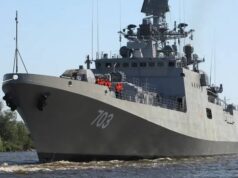Work Cut Out For Indian Defence Space Agency And Indian Defence Space Research Agency
 Avangard hypersonic weapon entered combat duty on Dec. 27, 2019 with the Russian Forces
Avangard hypersonic weapon entered combat duty on Dec. 27, 2019 with the Russian Forces
The USA Legislature enacted a new law to establish a separate Armed Force the sixth American Armed Force, the Space Force. The Force got constituted on 20 Dec 19.
On 27 Dec 19 a new intercontinental missile flying 27 times the speed of sound was fire tested in operational configuration by the Strategic Missile Forces, a separate Troop Branch of the Russian Armed Forces. The Russian Defense Minister Sergei Shoigu himself reported the success of the operational deployment of the Avangard Missile system to President Vladimir Putin. This had definitely bolstered the country’s nuclear strike capability.
Putin then described the success of the Avangard hypersonic glide vehicle as a technological breakthrough comparable to the 1957 Soviet launch of the first satellite. The development of this new Russian weapon had been troubling the United States for a long time and now it had arrived.
The Avangard system is a self guided system which initially rides on an intercontinental ballistic missile. However unlike a regular missile warhead that follows a predictable path after separation from the launch vehicle, Avangard it can make sharp maneuvers in the atmosphere on its way to the target, making it much harder to intercept.

Russian President Vladimir Putin, center, in meeting with Russian Defense Minister Sergei Shoigu, left, and Chief of General Staff of Russia Valery Gerasimov in the National Defense Control Center in Moscow, Russia
The Strategic Missile Forces chief, Gen. Sergei Karakayev, said during the call that the Avangard was put on duty with a unit in the southern Ural Mountains. Avangard was revealed among other prospective weapons systems by Putin in his state-of-the-nation address in March 2018, noting that its ability to make sharp maneuvers on its way to a target will render missile defense useless.
“It heads to target like a meteorite, like a fireball.” It is noted that Avangard is designed using new composite materials to withstand temperatures of up to 2,000 Celsius resulting from a flight through the atmosphere at hypersonic speeds.
The Avangard is capable of flying 27 times faster than the speed of sound. It carries a nuclear weapon of up to 2 megatons.
As per Putin, Russia had to develop the Avangard and other prospective weapons systems because of U.S. efforts to develop a missile defense system that he claimed could erode Russia’s nuclear deterrent. Moscow has scoffed at U.S. claims that its missile shield isn’t intended to counter Russia’s massive missile arsenals.
Russia is now the only country armed with hypersonic weapons. For the first time Russia is leading the world in developing an entire new class of weapons, unlike in the past when it was catching up with the U.S.
In December 2018, the Avangard was test launched and successfully hit a practice target 6,000 kilometers away. The Avangard will first be mounted on Soviet-built RS-18B intercontinental ballistic missiles, code-named SS-19 by NATO. It is expected to be fitted to the prospective Sarmat heavy intercontinental ballistic missile after it becomes operational.
The Defense Ministry said last month it demonstrated the Avangard to a team of U.S. inspectors as part of transparency measures under the New Start nuclear arms treaty with the U.S.
The Russian military previously had commissioned another hypersonic weapon of a smaller range.
China tested its hypersonic glide vehicle, believed to be capable of traveling at least five times the speed of sound. It displayed the weapon called Dong Feng 17, or DF-17, at a military parade marking the 70th anniversary of the founding of the Chinese state.
U.S. officials have talked about putting a layer of sensors in space to more quickly detect enemy missiles, particularly the hypersonic weapons. The administration also plans to study the idea of basing interceptors in space, so the U.S. can strike incoming enemy missiles during the first minutes of flight when the booster engines are still burning.
The Pentagon also has been working on the development of hypersonic weapons in recent years, and Defense Secretary Mark Esper said in August that he believes “it’s probably a matter of a couple of years” before the U.S. has one. He has called it a priority as the military works to develop new long-range fire capabilities.

India is too is pushing ahead with the development of ground and flight test hardware as part of an ambitious plan for a Hypersonic Missile. The DRDO HSTDV having attained autonomous scramjet flight using a solid rocket launch booster, helped India’s interest in reusable launch vehicles. The design for airframe with the engine was completed in the year 2004.
Russia too has provided critical help in the project. India’s main defense-industrial partner is Russia, which has carried out considerable research into hypersonic propulsion.
By November 2010, DRDO was in the process of opening four state-of-the-art facilities inside as well as in the vicinity of Hyderabad at a cost of more than ₹10 billion facility to facilitate testing of various parameters of the Hypersonic Technology Development Vehicle (HSTDV), including engine performance.
By December 2011, the scientists had proved technologies for aerodynamics, aero-thermodynamics, engine and hot structures through design and ground testing. They then began working on the mechanical and electrical integration, control and guidance system along with their packaging etc.
On June 12, 2019, the vehicle was tested from Abdul Kalam Island by the DRDO and it can cruise at Mach 6. According to the official statement by the Ministry of Defence, “the missile was successfully launched” and the data collected will be analysed to “validate critical technologies”.
The next aim is to test it at Mach 12 speed. The Defence Space Agency and the Defence Space Research Agency now need to speed up the project. There is now urgent need of setting up a Space Defence Command. We need to deploy own missile having speed of Mach 30.




